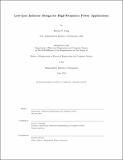Low-loss inductor design for high-frequency power applications
Author(s)
Yang, Rachel S.(Rachel Shanting)
Download1127567059-MIT.pdf (4.924Mb)
Other Contributors
Massachusetts Institute of Technology. Department of Electrical Engineering and Computer Science.
Advisor
David J. Perreault.
Terms of use
Metadata
Show full item recordAbstract
Miniaturization of power electronics can improve the performance of many applications, such as renewable energy systems, data centers, and aerospace systems. Operation in the high frequency (HF) regime (3{ 30 MHz) has potential for miniaturizing power electronics, but designing small, efficient inductors at HF can be challenging. At these frequencies, losses due to skin and proximity effects are difficult to reduce, and gaps needed to keep B fields low in the core add fringing field loss. This thesis aims to improve the design of HF inductors. A low-loss inductor structure for HF applications and associated design guidelines that optimize for loss have been developed. The structure achieves low loss through quasi-distributed gaps and a new field shaping technique that achieves low winding loss through double-sided conduction. An example ~15 [mu]H inductor designed using the proposed guidelines achieved an experimental quality factor of 720 at 3MHz and 2A (peak) of ac current. In some cases, litz wire may further improve the performance of the proposed structure. With litz wire, the example inductor achieved an improved quality factor of 980. The proposed structure also has great design and application flexibility. Core sets for this structure can be scaled by a factor-of-four in volume and still cover a large, continuous range of inductor requirements, e.g. power handling and inductances. A wide range of requirements can therefore be achieved with a small set of core pieces. The proposed inductor structure and design techniques thus have greater potential for commercial adoption to facilitate the design of low-loss HF inductors. The design techniques used in the proposed structure can also be extended to high-power radio-frequency (RF) applications, such as RF power amplifiers for industrial plasma generation. A modified version of the proposed structure, along with modified design guidelines, can achieve low loss in this operating space. Simulations show that an example ~600 nH inductor achieves a quality factor of 1900 at 13:56MHz and 78A (peak). Therefore, the developed design techniques and inductor structures are suitable for small, highly-efficient inductors at HF, and can thereby help realize high-frequency miniaturization of power electronics.
Description
This electronic version was submitted by the student author. The certified thesis is available in the Institute Archives and Special Collections. Thesis: M. Eng., Massachusetts Institute of Technology, Department of Electrical Engineering and Computer Science, 2019 Cataloged from student-submitted PDF version of thesis. Includes bibliographical references (pages 72-74).
Date issued
2019Department
Massachusetts Institute of Technology. Department of Electrical Engineering and Computer SciencePublisher
Massachusetts Institute of Technology
Keywords
Electrical Engineering and Computer Science.